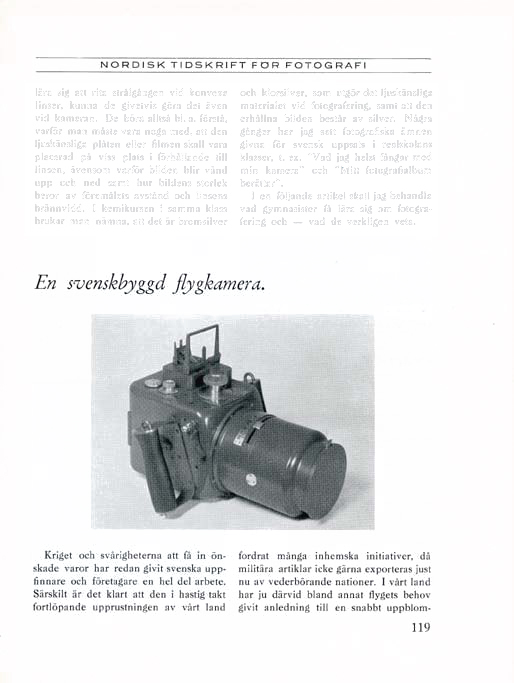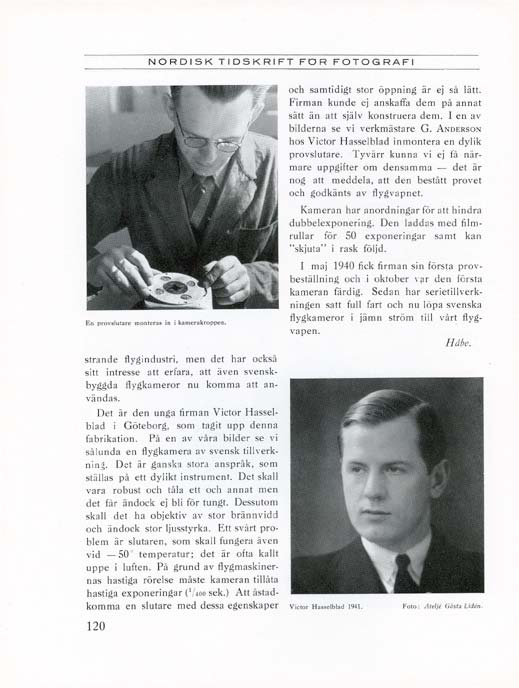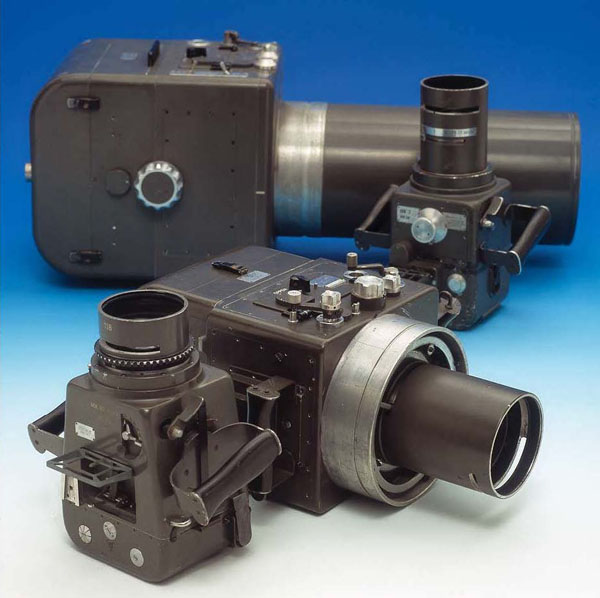Ross Military Cameras
By Charlie Chernoff
Part One - Introduction
Since none of us have all the hardware we would wish for, we must resort to borrowing from literature to
develop comprehensive factual summaries about our favorite cameras. The challenge in plagiarizing is to pick
out only the grain and ignore the chaff. An attempt has been made to do just that. The most glaring past
errors in documentation regards this narrow subject have been noted and corrected. However, studying past
documents is insufficient. Persons with a common interest must be engaged in dialogue so that we as searchers
for fact do not leap to premature conclusions.
Richard Nordin has participated enthusiastically in getting this summary regards Ross Military cameras as
complete and as uncorrupted as possible. Rick has some of the subject hardware that he studied and reported on,
he has European contacts who have been helpful, and furthermore he is a wizard at conducting Internet searches.
Rick is also cautious and has several times tempered my uncontrollable urge to speculate. You will notice,
however, that I did sneak a few assumptions by him.
Thank you to Charles Barringer, Vice President of Zeiss
Historica Society, who provided information on Zeiss lenses that were used on several Ross cameras. He
also respectfully suggested further study of several books and proffered alternate opinions on several issues.
We all owe Jan Lagerlöf heartfelt thanks for taking care of translations from Swedish to English and
for providing original information that he obtained when he made contact with the Swedish Air Force Museum.
I am solely responsible for any inappropriate statements and all mistakes. I look forward to you readers to
identify and rectify incorrect data or notions so that we can improve this first attempt and strive towards a
more complete and factual summary.
Nordisk Tidskrift för Fotografi
An aerial camera built in Sweden
Ross HK 7 |  |

A test shutter, built by Hasselblad's team, is mounted in a camera body by Gustaf Anders(s)on (also known as Gustaf Tranefors).
Victor Hasselblad, 1941. |
References are listed up front in case you want to dig these books out of your library and have them
available as we proceed through the summary.
- Afalter, Udo ; Kameras & Objektive ; Published by the author, 1993 ; ISBN
3-920890-18-3 ; Distributed by Lindemanns Verlag ; ISBN 3-89506-102-6.
- Karlsten, Evald ; Hasselblad : I am the camera ; Gullers International AB, 1981 ; ISBN
91-85228-61-3 (English), ISBN 91-85228-67-2 (German).
- Kingslake, Rudolph ; A History of the Photographic Lens ; Academic Press Inc., 1989 ; ISBN
0-12-408640-3.
- Nordin, Richard ; Hasselblad System Compendium ; Hove Books, 1998 ; ISBN 1-897802-10-2.
- Thiele, Hartmut ; Fabrikationsbuch Photooptik : I. Carl Zeiss Jena, 1890 - 1927
; Privatdruck München, 2005.
- Thiele, Hartmut ; Fabrikationsbuch Photooptik : II. Carl Zeiss Jena, 1927 - 1991
; Privatdruck München, 2005.
- Victor Hasselblad AB ; Hasselblad (company magazine) ; issue 3 ; 1974.
Websites:
- Göteborgs Stadsmuseum - GSM:050020 / kamerasamling
- http://62.88.132.23/pls/carlotta/VisaDelobjekt?pin_prtMasidn=430733
- http://62.88.132.23/pls/carlotta/VisaDelobjekt?pin_prtMasidn=430728
Above two Websites have information on the SKa 4 and SKa 4a Ross Aerial cameras.
Be careful, some specifications presented are suspicious and may be in error.
The intent of this submission is to expand knowledge about the several military cameras that Victor
Hasselblad and his 30 or so workmen designed and built for the Swedish Royal Airforce and the Swedish Army
during World War II. To correct misconceptions in our present knowledge base and add new fact we ask for
everyone’s participation.
Help can be in the form of fact that has not been recorded elsewhere or is at least
not reflected in the information presented in this summary. Outfit configurations and serial numbers of
cameras, magazines and lenses, are always welcome because we can then determine what lenses were used and
possibly when the lenses were obtained from Germany. We may also be able to improve the estimated number of
units built.
I would like to refer to this summary as a “living document” that will be updated many times as we collect
more information.
Before we begin recording information we have collected I think it is prudent to spend some time
correcting information that has been previously published. This way the reader will not be interrupting his
review of this summary caused by reflection on a conflict that may have been presented elsewhere.
"Hasselblad" factory magazine issue 3, 1974.
On page 8 the following statement appears in the first paragraph.
“Note that the HK 7 features a between-the-lens shutter, in contrast to 5x7 in. hand-held aerial cameras which
usually have a focal plane shutter”.
That is incorrect. The HK 7 Aerial cameras and MK 80 Land cameras examined have behind-the-lens leaf shutters and we assume all
others have behind-the-lens shutters.
The shutter does not have any identification on the front, while a spring-loaded film flattener obscures the
rear in the HK 7. The shutter on the MK 80 camera has no identification on front or rear.
Afalter
reported that shutters were built by Compur but that is a mistake. Richard Nordin reports examining factory
photographs showing Ross craftsman fabricating shutter leaves. The conclusion is that shutters were leaf
shutters that were manufactured in the Ross factory. The shutter does not have the full complement of speeds
usually found on commercial between-the-lens or behind-the-lens shutters. The shutter has speeds of 1/150,
1/250 and 1/400 seconds on the HK 7. There is substantial interconnect challenge involved if one wants to use
a lens with a between-the–lens shutter rather than a behind-the-lens shutter especially if one is providing
the facility for interchangeable lenses.
Also, behind-the-lens shutters are simpler, sturdier, cheaper and easier to repair than between-the–lens
shutters. There can be a disadvantage to using a behind-the-lens shutter. Depending on format size and shutter
opening diameter telephoto lenses beyond a certain focal length may vignette.
The following paragraph suggests that the HK 7 was in production from 1940 through 1943. More correctly the
camera was in design and prototyping in 1940 and by early 1941 Ross had assembled one unit; serial production
was from 1941 through 1943.
"Quick Interchangeable Lenses and Roll Film Magazines", Hasselblad company brochure.
Page two, second paragraph:
342 cameras were supplied to Swedish armed forces during the war years 1941-45. All
featured quickly interchangeable lenses and magazines.
Incorrect, all the HK 7 aerial cameras lacked
interchangeable magazines. Interchangeable magazines were first used in 1942 with the introduction of the
aerial camera Ska 4.
We are not yet certain about the quantity 342 but as we gather more information we may
be able to refine this number. At present the total number of cameras presumed made are 240 HK7, 70 SKa 4 and
Ska 4a, 70 MK 80 and 24 SKa 5 for a total of approximately 404 (see the accompanying summary table).
"Hasselblad Kameras & Objektive" (1993), by Udo Afalter.
On page 96, Afalter lists the standard objective for the SKa 4 as Carl Zeiss Tessar 1:4.5/105 mm. The focal length is a
typographical error. It should read 150mm.
Also he missed listing several additional lenses - refer to
the table below to see the remaining lenses.
On page 97, Afalter lists the 1:4.5 150 mm lens for the SKa 5. This is incorrect. The lenses
available for the SKa 5 are listed in the table below.
On page 97, Afalter reports in the specification table that the body size of the SKa 5 camera was 11.2 cm
by 15.0 cm by 17.5 cm.
This cannot be correct since the body would not be large enough to accommodate an
18 x 24 cm photo format.
On page 99, Afalter reports that 70 (serial numbers 1 thru 70) MK 80 land hand-cameras were manufactured.
However, all later cameras examined have serial numbers between 101 and 170.
It has been suggested that serial numbering begins at 101 and runs to 170. If anyone has MK 80 camera outfits
numbered under 101 (one hundred and one) please notify us promptly.
"Hasselblad System Compendium" (1998), by Richard Nordin
On page 14 Nordin states that the SKa 5 was another handheld camera. This is unlikely.
The SK stands for "Spanings Kamera" or reconnaissance camera. The camera was more than likely rigidly mounted
in the belly of the airplane. The camera does not have any handles attached nor any provision for attaching
handles. It is also a little too big and heavy a unit to hold comfortably.
Evald Karlsten relates a rather amusing incident that got Victor Hasselblad into the camera manufacturing
business. The Swedish Royal Air Force personnel brought a “captured” German handheld aerial camera to Victor
for his assessment. But here let Victor tell you in his own words.
I received an inquiry – can you make a camera like this? And they showed me the
captured German camera. I inspected it closely, and saw that it wasn’t anything very special. So I replied
truthfully: ‘No, I cannot make one like that, but I can make one better.’
Many believe that the reference to a “captured camera” is a concocted story but there may be much truth in
it. Although more appropriate terminology ought to be “recovered camera”. In a later posting we will examine
an alternative possibility to Swedish capture or Swedish purchase from Volk in Germany. That is another story
that needs verification.
A slight digression is probably worth pursuing at this juncture. Later in the compilation you will learn
that all lenses used by the Ross Military Outfits came from German companies, Zeiss, Schneider or Meyer-Gorlitz.
In fact, other than the first camera HK 7, Zeiss supplied all remaining lenses.
All lenses were not anti-reflection coated.
I have speculated that German companies had exported uncoated lenses because their first priority was to
provide such lenses to the German military or that the German military suppliers were keeping the technology
secret.
Charles Barringer offered a third possibility that seems most likely. He offered that Tessar type lenses
were the last to be coated because of the increased manufacturing time and increased cost and the lack of
perceived need for coating.
Maybe we ought to get some input from an optical expert’s book. Rudolf Kingslake in, "A History of the Photographic Lens", page 16, says:
An important limiting factor in all early lenses was the presence of interreflections
between various glass-air surfaces in the lens. This led to a general loss of light in the image, but the
worst consequence was the formation of ghost images and flare spots in the picture. Lenses having two or four
glass-air surfaces did not suffer unduly in this respect, and six glass-air surfaces were generally considered
acceptable.
All lenses used by Ross were Tessar-like or Tele-Tessar-like so all had six glass-air surfaces or fewer.
This meant that uncoated versions of such lenses were totally acceptable from an optical viewpoint and
preferred from a cost basis viewpoint.
If you are interested in determining the year of manufacture and possibly the delivery destination and
sometimes camera intended for; of your Ross Military Zeiss lens you can almost always find the lens serial
number in one of Thiele’s books which transpose Zeiss production from file card information to book form.
Of course, not all Zeiss prewar lenses are listed, there are a few gaps where card information is missing.
If you are reluctant to purchase the book because this may be the only serial number you ever search for then
send an inquiry to:
postmaster@hasselbladhistorical.eu
Front to back:
MK 80
SKa 4
HK 7
SKa 5 |  |
| Aerial camera. Hand held Royal Swedish Airforce | Aerial camera. Fixed mounting Royal Swedish Airforce | Aerial camera. Fixed mounting Royal Swedish Airforce | Land camera. Hand held Swedish Army | Aerial camera. Fixed mounting Royal Swedish Airforce |
| 7 x 9 cm 80 mm double perforated film 30 exposures daylight load
50 exposures darkroom load | 12 x 12 cm 130 mm double perforated film 200 exposures per cassette | 12 x 12 cm 130 mm double perforated film 200 exposures per cassette | 7 x 12 cm 80 mm double perforated film 23 exposures daylight load
38 exposures darkroom load | 18 x 24 cm 190 mm double perforated film 200 exposures per cassette |
| Fixed back | Interchangeable back | Interchangeable back | Interchangeable back | Interchangeable back |
| Thumb actuated, pivoted lever advances film and cocks shutter | Motorized, with intervalometer.
DC power supply battery or airplane | Motorized, with intervalometer.
DC power supply battery or airplane | Motorized, with intervalometer.
DC power supply battery or airplane | Motorized, with intervalometer.
DC power supply battery or airplane |
| 13.5 cm f/2.8 Zeiss Biotessar 24 cm f/4.5 Schneider Xenar 25 cm f/5.5 Meyer Tele-Megor | 15.2 cm f/4.5 Cooke Aviar 15 cm f/4.5 Zeiss Tessar 25 cm f/3.5 Zeiss Tele-Tessar 40 cm f/5.5 Meyer Tele-Megor | 15.2 cm f/4.5 Cooke Aviar 15 cm f/4.5 Zeiss Tessar 25 cm f/3.5 Zeiss Tele-Tessar 40 cm f/5.5 Meyer Tele-Megor | 16.5 cm f/2.8 Zeiss Tessar 32 cm f/6.3 Zeiss Tele-Tessar 60 cm f/8 Zeiss Tele-Tessar | 25 cm f/4.5 Zeiss Orthometer 25 cm f/4.5 Zeiss Tessar 50 cm f/5.6 Zeiss Tele-Tessar |
| Ross behind the lens shutter 1/150, 1/250, and 1/400 | Ross behind the lens shutter 1/150, 1/250, and 1/400 | Ross behind the lens shutter 1/150, 1/250, and 1/400 | Ross behind the lens shutter 1/150, 1/250, and 1/400 | Ross behind the lens shutter 1/150, 1/250, and 1/400 |
| 1941 - 1943 | 1942 - | 1943 ? | 1943 - | 1943 - |
| 240 Nos 1 thru 240
(Includes SKa 4a) | 70 Nos 101 thru 170, or 1 thru 70 | 240 Nos 1 thru 240
(Includes SKa 4) | 70 Nos 101 thru 170, or 1 thru 70 | Approx. 24 Nos 1 thru 24, or 101 thru 124 |
| User manual | | | User manual | |
Copyright 2007, 2008 - Charlie Chernoff. All rights reserved.
All material on this site is protected by law. Unauthorized use is prohibited.
- Hasselblad Historical -
Page last updated: november 15, 2008.